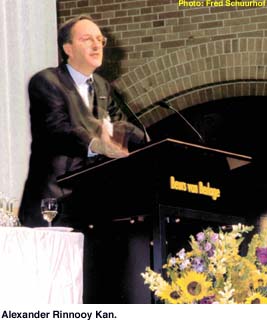Alexander Rinnooy Kan, Executive Board ING Group
Technology and its Impact on the Financial Services Industry
 Technology has affected the financial services industry in two waves. An internal wave, which started in the 1960s, has led to considerable cost savings, centralization and outsourcing, technologies that have really transformed the field (data mining), and new operating procedures (risk management). A second, more fundamental external wave is caused by technology itself driving new business models. It has changed the market and the relationship with clients and competitors, and it has generated new ways to interact with both of them.
Technology has affected the financial services industry in two waves. An internal wave, which started in the 1960s, has led to considerable cost savings, centralization and outsourcing, technologies that have really transformed the field (data mining), and new operating procedures (risk management). A second, more fundamental external wave is caused by technology itself driving new business models. It has changed the market and the relationship with clients and competitors, and it has generated new ways to interact with both of them.
ICT has brought enormous reduction in costs, for example by automatizing labour-intensive processes. Handling costs of transactions through Internet are up to a factor hundred less than those of a traditional branch personnel-based transaction.
Outsourcing has become a quite common phenomenon in the finance industry, for example payment systems. The recent outsourcing of R&D in particular gives the ICT research community great opportunities. Financial institutions have to deal with market risks, business risks, and even operational risks, and indeed, selling and repackaging risks is one of the core competences of the financial industry. However, we still have to find the right mathematical models, which calls for expertise in areas like stochastics, numerical analysis, partial differential equations, and optimization.
The second, external wave has fundamentally changed the way in which we distribute our services and gain access to our customers. It started in wholesale finance (abandonment of face-to-face security trading) and is now rapidly spreading into retail finance as well. Electronic money is a reality and E-finance solutions are rapidly gaining customer acceptance. The world is changing before our very eyes.
The following examples illustrate the issues coming up. First, there is an enormous problem with legacy systems. Several assumptions underlying the traditional approach turn out to be false, for example that old legacy systems should be fully replaced, and that systems are best designed in their entirety first and then constructed. Our experience is that in view of the rapidly changing environments the system should be modular. We hope to build the new systems by supplementing the old. There are ever better ways to do so because our systems are increasingly broken down into four fairly separate parts: user interface, error prevention component, database component, and core logic. At ING systems are frequently improved by just replacing the user interface.
Second, we are witnessing a dramatic decrease in the time-to-market. Traditionally the development cycle of a new product or service with a heavy IT-component is 8-9 years, whereas the market perspectives today require 2-3 years at most. This requires another business style of cooperation, including significant outsourcing. As a result the fundamental role of IT staff is changing. Computer centres will be joining external centres, becoming much less dependent on the core business. Outside professionals will increasingly build IT functionality. And finally, locally employed support groups should better cope with the needs of our business units. For a proper way to organize our renovation process we need contacts with communities such as ERCIM. A special handicap is that the service industry still lacks the tradition of industrial groups with well-established R&D contacts.
The third example is pervasive computing. Developments like Internet finance and (mobile) telephone finance are of crucial importance. Industry realizes that to work with these new technologies implies the need for open interoperable standards. As soon as that is realized our future customers will use mobile phones, TVs, laptops, and desktops whenever it suits them best. Things are moving here very rapidly indeed.
Looking at all these truly dazzling perspectives, it is stunning that so few people under twenty-five feel inspired by them. This ought to worry us all: ICT and mathematics clearly are increasingly important for society, but interest by students for these disciplines as well as the general public seems to decrease. The numbers for The Netherlands are dramatic: since the early nineties the number of newly enrolled students has almost halved for many of these disciplines, few female students are driven to them, and only 10% of the graduates finds a research job. We should ensure a higher intake of students in science and technology, create the right educational facilities, emphasize the fantastic career possibilities, and provide the right material incentives, also in terms of career perspectives.
